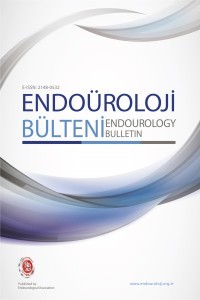Böbrek Taş Lokalizasyonuna Göre Perkütan Nefrolitotomi Operasyonlarının Başarı Ve Komplikasyon Oranlarının Karşılaştırılması
Böbrek taş, Ürolitiyazis, Perkütan nefrolitotomi, Taşsızlık oranı, Komplikasyon
Comparison of Success and Complication Rates of Percutaneous Nephrolithotomy Operations According to Kidney Stone Localization
___
- 1. Zeng G, Zhong W, Pearle M, et al. European association of urology section of urolithiasis and international alliance of urolithiasis joint consensus on percutaneous nephrolithotomy. European urology focus. 2022;8.2:588-597. https://doi.org/10.1016/j.euf.2021.03.008
- 2. Jahrreiss V, Özsoy M, Seitz C, et al. Past, present and future of genomics for kidney stone disease. Current Opinion in Urology. 2023;33.2:73-76. https://doi.org/10.1097/MOU.0000000000001064
- 3. Madaminov M, Shernazarov F. Causes, symptoms, diagnosis and treatment of kidney stones (urolithiasis). Science and Innovation. 2022;1.8:760-765. https://doi.org/10.5281/zenodo.744180
- 4. Türk C, Petřík A, Sarica K, et al. EAU guidelines on interventional treatment for urolithiasis. European urology. 2016;69(3):475-82. https://doi.org/10.1016/j.eururo.2015.07.041
- 5. Geraghty RM, Davis NF, Tzelves L, et al. Best practice in interventional management of urolithiasis: an update from the European Association of Urology Guidelines Panel for Urolithiasis 2022. European Urology Focus. 2023;9(1):199-208. https://doi.org/10.1016/j.euf.2022.06.014
- 6. Zhou G, Zhou Y, Chen R, et al. The influencing factors of infectious complications after percutaneous nephrolithotomy: a systematic review and meta-analysis. Urolithiasis. 2022;51.1:17. https://doi.org/10.1007/s00240-022-01376-5
- 7. Wollin DA, Preminger GM. Percutaneous nephrolithotomy: complications and how to deal with them. Urolithiasis. 2018;46(1):87-97. https://doi.org/10.1007/s00240-017-1022-x
- 8. Ghani KR, Andonian S, Bultitude M, D et al. Percutaneous nephrolithotomy: update, trends, and future directions. European urology. 2016;70(2):382-96. https://doi.org/10.1016/j.eururo.2016.01.047
- 9. Un S, Cakir V, Kara C, et al. Risk factors for hemorrhage requiring embolization after percutaneous nephrolithotomy. Canadian Urological Association Journal. 2015;9.9-10:E594. https://doi.org/10.5489/cuaj.2803
- 10. Oner S, Okumus MM, Demirbas M, et al. Factors influencing complications of percutaneous nephrolithotomy: a single-center study. Urology Journal. 2015;12.5:2317.
- 11. Mousavi-Bahar, Seyed Habibollah; Mehrabi, Sasan;et. al. Percutaneous nephrolithotomy complications in 671 consecutive patients: a single-center experience. Urology journal. 2011;8
- 12. de la Rosette J, Assimos D, Desai M, et al. The Clinical Research Office of the Endourological Society Percutaneous Nephrolithotomy Global Study: indications, complications, and outcomes in 5803 patients. J Endourol. 2011;25:11-7. https://doi.org/10.1089/end.2011.0146
- 13. Zhang W, Zhou T, Wu T, et al. Retrograde intrarenal surgery versus percutaneous nephrolithotomy versus extracorporeal shockwave lithotripsy for treatment of lower pole renal stones: a meta-analysis and systematic review. Journal of Endourology. 2015;29(7):745-59. https://doi.org/10.1089/end.2014.0799
- 14. Chen Y, Feng J, Duan H, et al. Percutaneous nephrolithotomy versus open surgery for surgical treatment of patients with staghorn stones: A systematic review and meta-analysis. PloS one. 2019;14(1):e0206810. https://doi.org/10.1371/journal.pone.0206810
- 15. Ucer O, Erbatu O, Albaz AC, et al. Comparison stone-free rate and effects on quality of life of percutaneous nephrolithotomy and retrograde intrarenal surgery for treatment of renal pelvis stone (2-4 cm): A prospective controlled study. Current Urology, 2022;16.1:5. https://doi.org/10.1097/CU9.0000000000000071
- 16. ElSheemy MS, Elmarakbi AA, Hytham M, et al. Mini vs standard percutaneous nephrolithotomy for renal stones: a comparative study. Urolithiasis. 2019;47:207-14. https://doi.org/10.1007/s00240-018-1055-9
- 17. Karalar M, Tuzel E, Keles I, et al. Effects of parenchymal thickness and stone density values on percutaneous nephrolithotomy outcomes. Medical science monitor: International medical journal of experimental and clinical research. 2016;22: 4363. https://doi.org/10.12659/MSM.898212
- 18. Bayar G, Kadihasanoglu M, Aydin M, et al. The effect of stone localization on the success and complication rates of percutaneous nephrolithotomy. Urology journal. 2014;11(6).
- Yayın Aralığı: Yılda 3 Sayı
- Başlangıç: 2020
- Yayıncı: ENDOÜROLOJİ DERNEĞİ
Genital Siğillerin Erkeklerin Depresyonu ve Cinsel İşlevleri Üzerindeki Etkisi
Üreter Taşlarında Üreterorenoskopik Holmiyum: YAG Lazer Litotripsi Etkinliğini Etkileyen Faktörler
Genç Yaşta Görülen Transizyonel Hücreli Mesane Karsinomunda Genetik Yatkınlık Var Mıdır?
Selim TAŞ, Ali Erhan EREN, Mahmut Taha ÖLÇÜCÜ, Barış PAKSOY, Ekrem İSLAMOĞLU, Mehmet Salih BOĞA
Robot Yardımlı Böbrek Naklinde Bifazlı Sıvı Tedavisi’nin Etkinliği
Burhan COŞKUN, Halit Mustafa ACAR, Ahmet Eren TOTO, Gökhan OCAKOĞLU, Omer Faruk ASLAN, Onur KAYGİSİZ
Kompleks Üst Üriner Sistem Taş Tedavisinde Robotik Cerrahinin Rolü: Tek Merkez Deneyimi
Murat Can KİREMİT, Yakup KORDAN
Burhan COŞKUN, Sezin TÜRK KAYA, Yavuz Mert AYDIN, İsmail İFŞA, Seniha GÜNDÜZ, Hakan KILIÇARSLAN
